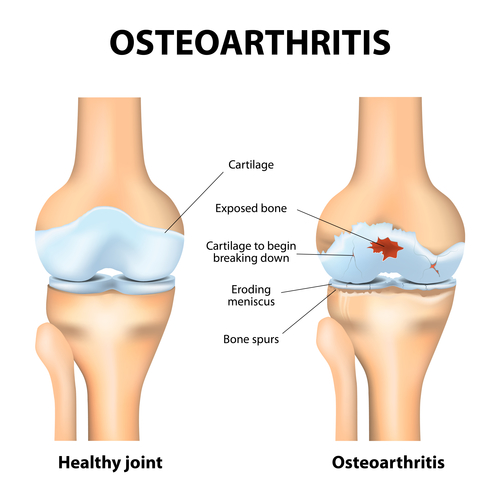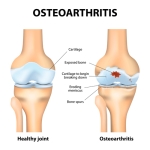
No one knows the exact cause of knee osteoarthritis, but most people who develop osteoarthritis have at least one of the traits below.
Two chief risk factors for developing knee osteoarthritis are advanced age and obesity:
Advanced age: While adults of any age may develop knee osteoarthritis, the prevalence of symptomatic knee osteoarthritis increases rapidly starting at age 45 and continues to increase thereafter. The prevalence increases with age because with age the knee joints experience wear and tear and cartilage thin and becomes less flexible, making it more prone to osteoarthritis. The degeneration of the joints that is characteristic of osteoarthritis is why the condition is also called “degenerative joint disease”.
Excess weight/obesity: Knees are weight-bearing joints and a person who is overweight or obese is significantly more likely to develop knee osteoarthritis. For example:
-
Nearly 2 out of 3 people who are obese are likely to develop knee osteoarthritis.
-
Losing even a few pounds can significantly reduce the risk.
In addition to the above, other risk factors for developing knee osteoarthritis include:
Joint trauma: A broken bone, serious injury or surgery may cause damage to the knee joint that eventually leads to knee osteoarthritis, although symptoms may not appear until many years later. Osteoarthritis that develops as a result of the previous injury is usually termed Traumatic Arthritis or Post-Traumatic Arthritis.
Family history: Similar to height and hair color, the likelihood of a person developing knee osteoarthritis is influenced by genetics; a woman whose mother has knee osteoarthritis is more likely to develop the disease than another woman whose mother did not have the knee osteoarthritis. While the exact extent of genetic factors is not known, the CDC estimates between 20% to 35% of incidences of knee arthritis may be inherited.
Congenital defect or illness: Episodes of gout or septic arthritis, as well as metabolic disorders, poor bone alignment, and other congenital conditions can increase the risk of developing osteoarthritis of the knee.
Joint stress and chronic injury: People whose regular activities or jobs require spending a lot of time on their feet, doing the heavy lifting while standing, squatting or crawling (e.g. installing carpets) can experience “mini-traumas” in their knee joints and are more likely to develop osteoarthritis. Athletes who participate in high impact sports (e.g. tennis, football) may also be more prone to developing knee osteoarthritis.
Gender: Women are more likely than men to develop osteoarthritis in the knee.
While the above risks factors predispose certain individuals to osteoarthritis, they are not absolutely causative: people without the above risk factors may develop the condition and people with all of the above characteristics may never develop it.
If knee pain comes on suddenly, it is more likely to be caused by trauma or another condition, not by knee osteoarthritis. If the knee feels hot or the skin around the joint turns red, then a diagnosis other than osteoarthritis may be the culprit. This could indicate an infection, and an infected knee joint requires immediate medical attention.













